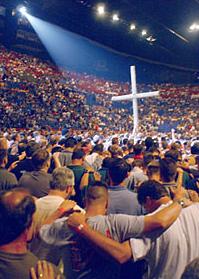 We here at GetReligion typically like just about everything the Los Angeles Times' Stephanie Simon writes. She thrives on writing highly descriptive narratives that manage to touch on all sorts of issues, usually with religious themes. For instance, her piece on abortion still sticks in my mind and is a must read for journalists covering the subject.
That said, an article by Jenny Jarvie and Simon on manliness in Christianity missed a couple of aspects that would have painted a more complete picture. As a regular church-attending man, I appreciate that this subject is being addressed in a national newspaper. The concept of the article is relatively simple: men are disappearing from church and some people think they have the answer.
We here at GetReligion typically like just about everything the Los Angeles Times' Stephanie Simon writes. She thrives on writing highly descriptive narratives that manage to touch on all sorts of issues, usually with religious themes. For instance, her piece on abortion still sticks in my mind and is a must read for journalists covering the subject.
That said, an article by Jenny Jarvie and Simon on manliness in Christianity missed a couple of aspects that would have painted a more complete picture. As a regular church-attending man, I appreciate that this subject is being addressed in a national newspaper. The concept of the article is relatively simple: men are disappearing from church and some people think they have the answer.
More than 60 percent of the adults in church these days are women, which, as pointed out by one of the article's sources, means there are 13 million more women than men worshiping God on Sunday mornings. The theme of the article, as discussed by multiple sources, is "Houston, we have a problem."
While I have a couple of issues with the article's content, it is a wonderfully written piece full of delightful details and fun-to-read vignettes, such as the lede:
The strobe lights pulse and the air vibrates to a killer rock beat. Giant screens show mayhem and gross-out pranks: a car wreck, a sucker punch, a flabby (and naked) rear end, sealed with duct tape.
Brad Stine runs onstage in ripped blue jeans, his shirt untucked, his long hair shaggy. He's a stand-up comic by trade, but he's here today as an evangelist, on a mission to build up a new Christian man -- one profanity at a time. "It's the wuss-ification of America that's getting us!" screeches Stine, 46.
A moment later he adds a fervent: "Thank you, Lord, for our testosterone!"
 The first question I felt the authors failed to address is why and how American Christianity became this way. Where have all the men gone, and why? It's established in the article that churches these days are more feminine -- everything from the decor to the hymns -- but is that because the church has become intentionally more feminine or because the men have left for other reasons and femininity has filled the gap?
The first question I felt the authors failed to address is why and how American Christianity became this way. Where have all the men gone, and why? It's established in the article that churches these days are more feminine -- everything from the decor to the hymns -- but is that because the church has become intentionally more feminine or because the men have left for other reasons and femininity has filled the gap?
Since I can think of about a dozen different variations on these questions, maybe it's time for a follow-up article?
Second, while the disappearing men is a well-established trend and it is made clear in the article, little effort was made to tell us if this attempt to inject more manliness into Christianity is a resurgence or just a handful of men trying to apply their view of things on whoever will listen.
In other words, have the efforts of these Manly Christians brought more men to Christianity? John Eldredge's book Wild At Heart has been around since at least I was a sophomore in college. Has that bestseller made a difference in the gender-pew gap?
That all said, the article is incredibly insightful at times. A few doubters are quoted, as well as a couple of examples that some would say are taking the Man Doctrine a bit too far. All in all, it's a pretty straightforward balanced picture of the movement, if you can call it that.
For an example of the insightful, take the following word picture:
The 200 men in the crowd clap stiffly. Stine races through a frenetic stand-up routine, drawing laughs with his rants against liberals, atheists and the politically correct. Then Christian radio host Paul Coughlin, author of "No More Christian Nice Guy," takes the stage. His backdrop: a series of wanted posters featuring one Jesus of Nazareth.
"Jesus was a very bad Christian," Coughlin declares. After all, he says, the Son of God trashed a temple and even used profanity -- or the New Testament equivalent -- when he called Herod "that fox."
"The idea of Jesus as meek and mild is as fictitious as anything in Dan Brown's 'Da Vinci Code,'" says Coughlin, 40.
So what's with the standard portraits of Jesus: pale face, beatific smile, lapful of lambs?
 That last graph is, like, wow. With a simple sentence Simon and Jarvie subtly threaten to turn the GodMen concept on its head. And if I'm reading it right, the headline -- "Manliness is next to godliness" -- has the same subtle message.
That last graph is, like, wow. With a simple sentence Simon and Jarvie subtly threaten to turn the GodMen concept on its head. And if I'm reading it right, the headline -- "Manliness is next to godliness" -- has the same subtle message.
Simon and Jarvie are also on to something in one of their final observations:
The ironic bit about all this rough-and-tumble manliness is that it often leads to what can only be described as touchy-feely moments.
Eldredge runs "soul-searching" wilderness retreats in Colorado that prompt men to bare their innermost needs. Men's Fraternity gets guys talking about their psychological "wounds" and encourages them to ask their dads: Do you love me? Are you proud of me? BattleZone Ministries, based in Clovis, Calif., has posted an online video on how to pray for a man without freaking him out -- but its recommended approach still involves guys laying hands on their buddy.
As a man, I appreciate that observation from Simon and Jarvie. I would also like to say, though, that there is nothing ironic about "rough-and-tumble" men wanting to find ways to dig deep into their souls. Could the perception that those are somehow mutually exclusive be a reason churches are losing their men?
